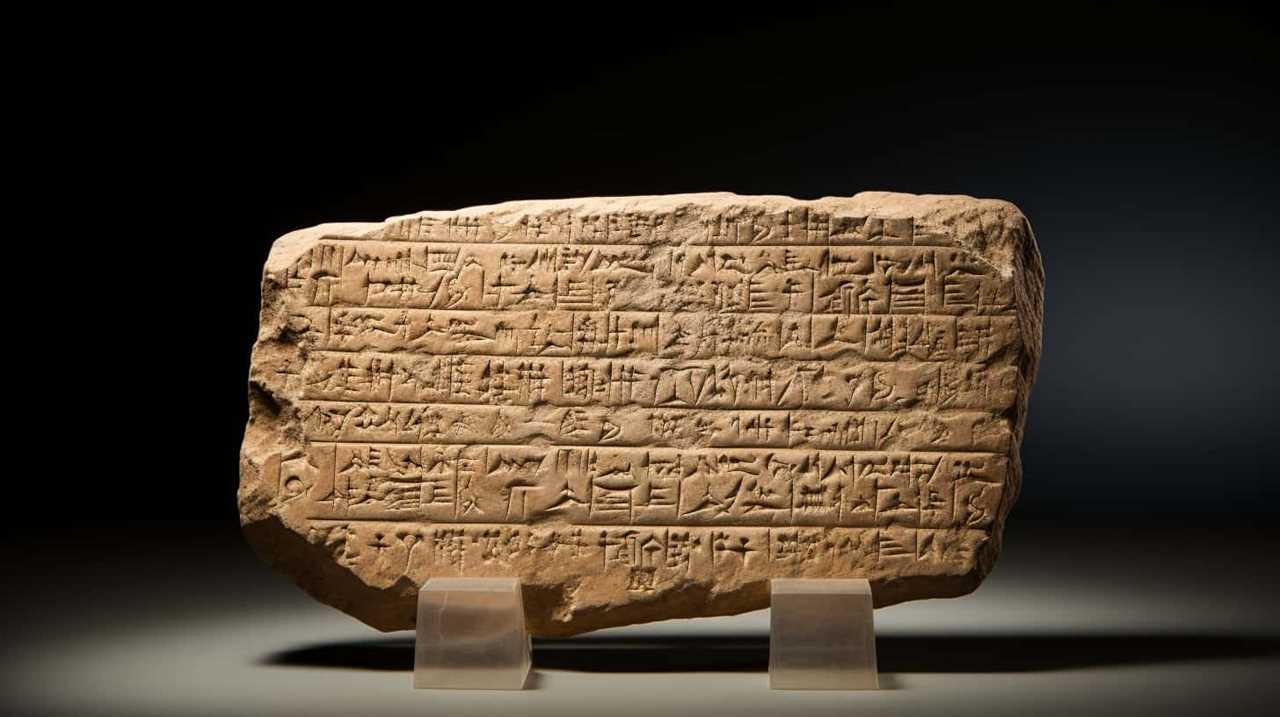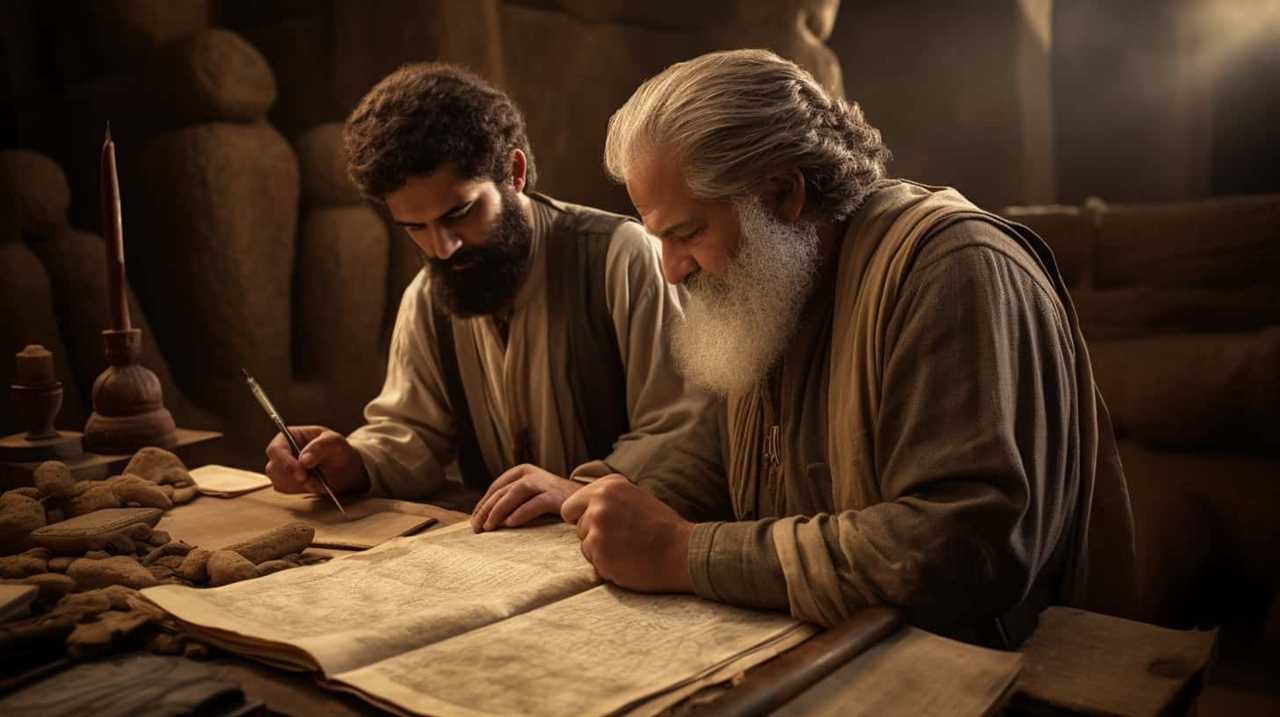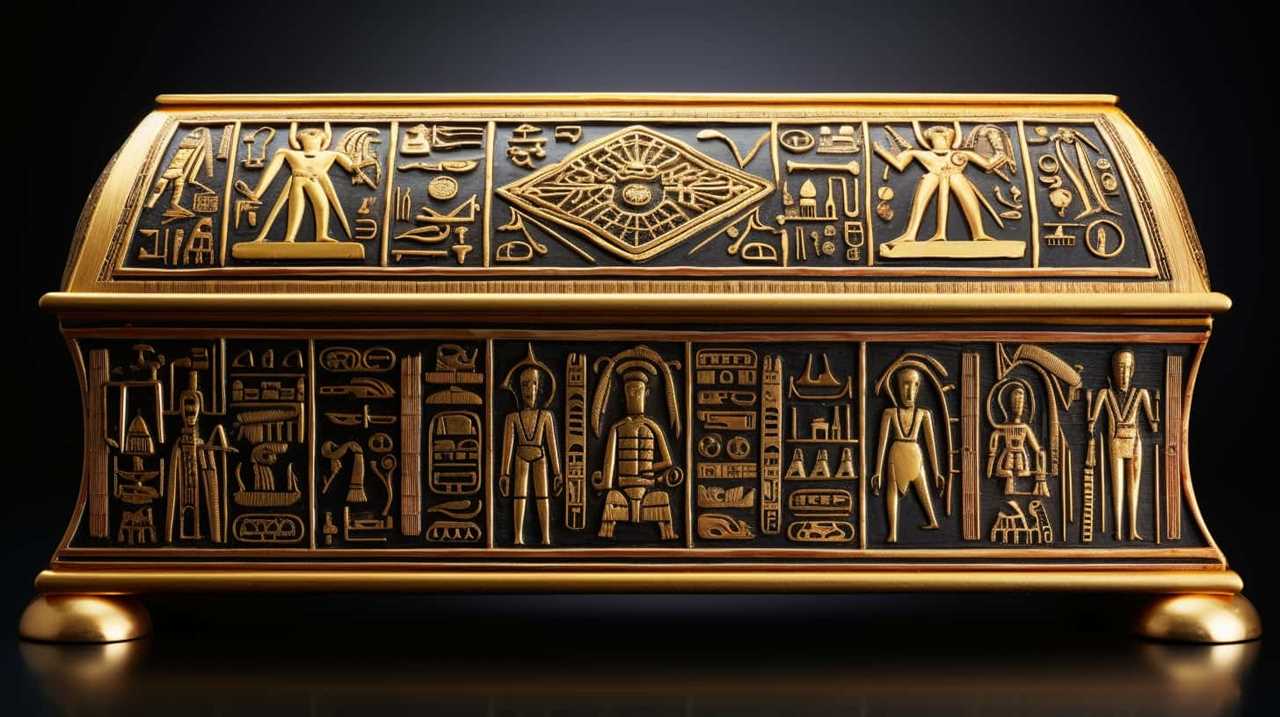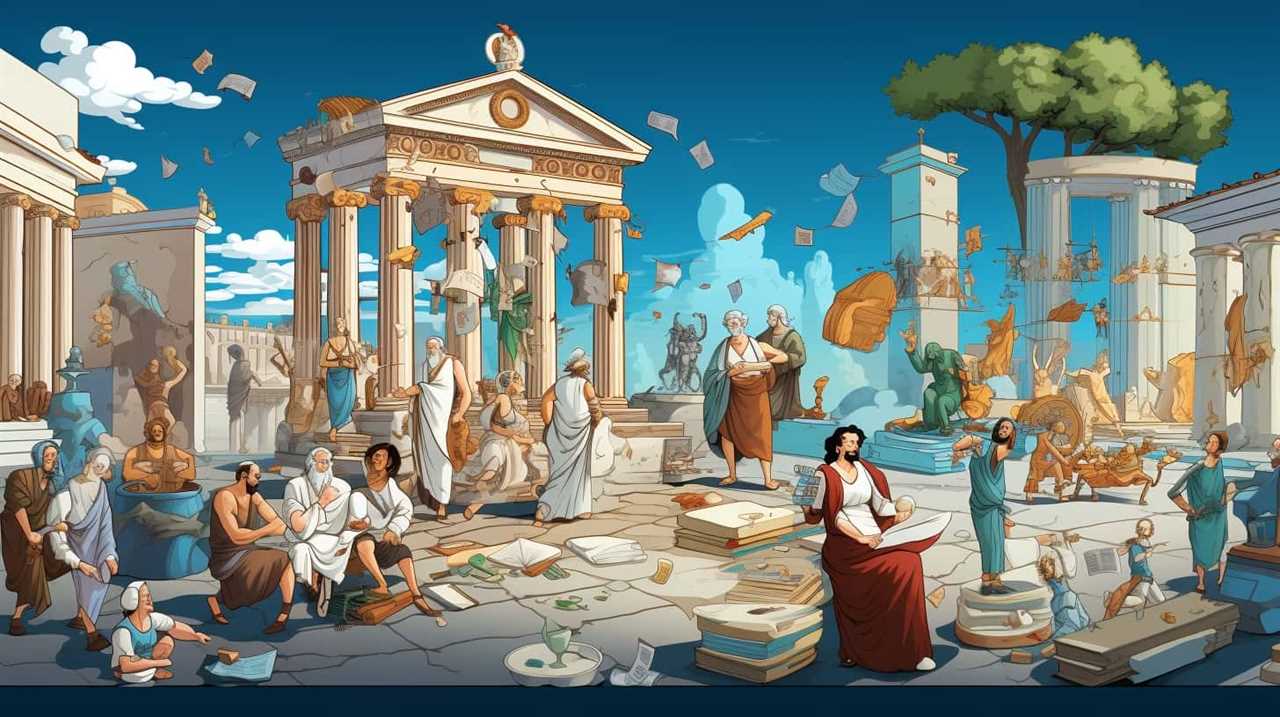Exploring Life Through Confucius’ Motivational Guidance offers a transformative journey for those striving for greatness. While some may argue that ancient wisdom is irrelevant in today’s fast-paced world, we believe that Confucius’ teachings hold timeless truths that can lead us to a fulfilling and purposeful existence.
By embracing the virtue of self-reflection, we can uncover our true selves and make conscious choices that align with our values. Through cultivating kindness, inner harmony, and balance, we can foster harmonious relationships and create a positive impact on the world around us.
Education and lifelong learning empower us to constantly grow and evolve. By valuing filial piety in our family relationships and embracing integrity in all our actions, we can build a strong foundation for a meaningful life. Balancing individual rights with social responsibilities allows us to contribute to the greater good while maintaining our individuality.
Drawing wisdom from the past, we can pave the way for future growth and progress. Join us as we embark on this incredible journey of self-development and discover the profound teachings of Confucius that will inspire and guide us in navigating life’s challenges.

Key Takeaways
- Self-reflection and personal growth are essential for understanding oneself, identifying areas for improvement, and aligning actions with values and goals.
- Kindness and compassion play a crucial role in fostering positive relationships, creating a harmonious society, and promoting personal well-being.
- Lifelong learning and personal development empower constant growth, adaptability, and the acquisition of transferable skills for navigating the complexities of the world.
- Community engagement and social harmony are achieved through active participation, respect for cultural norms, building inclusive environments, and fostering unity within communities.
The Importance of Self-Reflection
Self-reflection plays a crucial role in our lives as it allows us to gain a deeper understanding of ourselves and our actions. The role of self-reflection in personal growth can’t be overstated. It’s through self-reflection that we’re able to examine our thoughts, emotions, and behaviors, and make necessary adjustments for self-improvement. By taking the time to reflect on our experiences and interactions, we foster self-awareness and gain insight into our strengths, weaknesses, values, and beliefs. This self-awareness then becomes the foundation upon which personal growth can occur.
Self-reflection provides us with the opportunity to analyze our actions and their consequences. It allows us to identify patterns and behaviors that may be hindering our progress and preventing us from reaching our full potential. Through self-reflection, we can recognize areas in need of improvement and develop strategies to address them. This process of self-improvement is essential for personal growth and development.
Moreover, self-reflection enables us to make better decisions and choices. By examining our thoughts, motivations, and intentions, we become more mindful and intentional in our actions. This heightened self-awareness empowers us to align our actions with our values and goals, leading to a more fulfilling and purpose-driven life.
Embracing the Virtue of Kindness
When considering the virtue of kindness, we must recognize its role as a moral compass in our lives. Kindness serves as a guiding principle, directing our actions towards empathy and compassion.

It’s through acts of kindness that we’ve the power to profoundly impact the lives of others, fostering connection, understanding, and unity.
As we navigate the complexities of life, it’s imperative that we cultivate kindness daily, recognizing its ability to transform not only the lives of others but our own as well.
Kindness as Moral Compass
As we navigate through life, kindness serves as our moral compass, guiding us towards virtuous actions and compassionate interactions with others. Kindness plays a crucial role in both our relationships and our workplace, shaping the way we engage with those around us. In relationships, kindness fosters trust, empathy, and understanding. It allows us to be patient and forgiving, creating a harmonious and supportive environment. Similarly, in the workplace, kindness promotes collaboration, respect, and a positive work culture. It encourages teamwork, boosts morale, and enhances productivity. By embodying kindness in our daily lives, we not only benefit ourselves but also contribute to the well-being of others. It is through acts of kindness that we can create a world filled with compassion, understanding, and harmony.
| Kindness in Relationships | Kindness in the Workplace |
|---|---|
| Fosters trust, empathy, and understanding | Promotes collaboration, respect, and positive work culture |
| Creates a harmonious and supportive environment | Boosts morale and enhances productivity |
| Encourages patience and forgiveness | Fosters teamwork |
| Contributes to the well-being of others | Creates a world filled with compassion and harmony |
Impact of Kindness
Embracing the virtue of kindness has a profound impact on our lives, shaping our interactions and fostering a sense of empathy and compassion towards others.

The power of compassion can’t be underestimated, as it has the ability to transform not only our own lives but also the lives of those around us. When we choose to act with kindness, we create a ripple effect that spreads positivity and goodwill.
Our acts of kindness inspire others to do the same, creating a chain reaction of compassion. This ripple effect of kindness has the potential to create a more harmonious and compassionate society, where individuals are motivated to support and uplift one another.
Cultivating Kindness Daily
We strive to cultivate kindness daily, as it allows us to embody the virtue of compassion and create a positive impact on those around us. Daily acts of spreading kindness not only benefit others but also contribute to our own personal growth and well-being. Here are three ways we can actively cultivate kindness in our daily lives:
- Practice acts of random kindness: Small gestures like holding the door for someone, offering a smile, or lending a helping hand can go a long way in brightening someone’s day.
- Show empathy and understanding: Taking the time to listen and understand others’ perspectives can foster empathy and create deeper connections with those around us.
- Practice gratitude: Expressing appreciation for the people and things in our lives can help cultivate kindness and foster a positive mindset.
By incorporating these daily acts of kindness into our lives, we can create a ripple effect of positivity and inspire others to do the same.

Transitioning into the next section, cultivating inner harmony and balance also requires a mindset grounded in kindness and compassion.
Cultivating Inner Harmony and Balance
As we delve into the subtopic of ‘Cultivating Inner Harmony and Balance,’ it’s important to explore the notion of achieving personal equilibrium.
In our fast-paced world, it’s crucial to find ways to balance our work and personal lives, ensuring that we allocate time and energy to both areas.
Achieving Personal Equilibrium
To cultivate inner harmony and balance, we must actively pursue a state of equilibrium in our lives. Achieving personal equilibrium requires a deliberate effort to prioritize self-care and finding inner peace. Here are three key strategies to help us cultivate this equilibrium:

- Mindfulness: By practicing mindfulness, we can become more aware of our thoughts, emotions, and sensations in the present moment. This awareness allows us to better understand ourselves and make conscious choices that promote balance and harmony.
- Self-reflection: Taking time for self-reflection enables us to gain insight into our values, beliefs, and goals. Through introspection, we can identify areas of imbalance and make necessary adjustments to align with our authentic selves.
- Establishing boundaries: Setting healthy boundaries is essential for maintaining personal equilibrium. It involves understanding our limits, saying no when necessary, and prioritizing our well-being. By establishing boundaries, we create space for self-care and maintain a healthy balance between our personal and professional lives.
Balancing Work-Life Priorities
Finding a balance between our work and personal lives is crucial for cultivating inner harmony and achieving a state of equilibrium. In today’s fast-paced world, it can be challenging to juggle our professional responsibilities and personal commitments. However, by practicing effective time management and prioritization, we can create a harmonious work-life balance.
To illustrate the importance of work-life balance, let us consider the following table:
| Work Life Balance | Time Management |
|---|---|
| Allows for personal growth and development | Helps in setting goals and priorities |
| Reduces stress and burnout | Enhances productivity and efficiency |
| Fosters healthy relationships | Enables better decision-making |
The Power of Education and Lifelong Learning
Education empowers us to continually learn and grow throughout our lives, shaping our perspectives and enabling us to navigate the complexities of the world with confidence. The power of continuous learning lies in its ability to expand our knowledge and understanding, allowing us to adapt to changing circumstances and make informed decisions.
Intellectual curiosity, a key driver of lifelong learning, offers numerous benefits that contribute to our personal and professional development.

- Broadened horizons: Engaging in continuous learning broadens our horizons by exposing us to diverse ideas, cultures, and perspectives. It encourages us to question assumptions, challenge biases, and develop a more nuanced understanding of the world.
- Enhanced critical thinking skills: Lifelong learning cultivates our ability to think critically and analyze information effectively. It equips us with the tools to evaluate evidence, identify logical fallacies, and make well-informed judgments.
- Increased adaptability: Education fosters adaptability by instilling a growth mindset and teaching us to embrace change. It equips us with transferable skills that enable us to thrive in dynamic environments and seize new opportunities.
The Value of Filial Piety in Family Relationships
Filial piety, a cherished virtue in Confucian teachings, strengthens and nurtures family relationships, fostering love, respect, and harmony among generations. The concept of filial piety centers around the parent-child bond, emphasizing the importance of showing reverence, care, and obedience to one’s parents. It isn’t simply about fulfilling one’s duties towards parents, but also about cultivating respectful relationships built on mutual understanding and appreciation.
In Confucian philosophy, filial piety is regarded as the foundation of a harmonious society. By honoring and respecting our parents, we learn the value of respecting authority, fostering empathy, and maintaining harmony within the family unit. This virtue extends beyond mere obedience; it requires a deep sense of gratitude, devotion, and selflessness towards our parents.
Respecting our parents and upholding the principles of filial piety creates a strong foundation for building strong and ethical leadership skills. The lessons learned from filial piety, such as self-discipline, responsibility, and empathy, are essential qualities in becoming effective leaders. These qualities enable us to understand the needs and concerns of others, make wise decisions, and cultivate harmonious relationships within our communities.
Transitioning into the subsequent section about building strong and ethical leadership skills, we can see that the value of filial piety goes beyond family relationships. It’s a fundamental virtue that shapes our character and prepares us for leadership roles in society.

Building Strong and Ethical Leadership Skills
When it comes to building strong and ethical leadership skills, one of the key aspects is leading with integrity. This means consistently acting in accordance with moral and ethical principles, even in the face of challenges or temptations.
Ethical decision making is another crucial skill for effective leadership, as leaders must navigate complex situations and make choices that align with their values and the greater good.
Leading With Integrity
As leaders, we prioritize integrity to cultivate strong and ethical leadership skills. Leading with honesty and ethical leadership is essential for maintaining trust and credibility among our team members and stakeholders.
To effectively lead with integrity, we must:

- Model ethical behavior: By consistently demonstrating honesty, fairness, and transparency, we set a positive example for others to follow.
- Make ethical decisions: We must consider the impact our decisions have on others and society as a whole. This requires weighing the ethical implications and choosing the course of action that aligns with our values and principles.
- Foster a culture of integrity: Creating an environment where ethical behavior is encouraged and rewarded helps to instill a sense of responsibility and accountability in our team members.
Ethical Decision Making
To strengthen our leadership skills and foster an environment of integrity, we prioritize ethical decision-making. Ethical decision making requires a strong moral compass, which guides us in choosing the right course of action. Confucius’ teachings provide valuable insights into building strong and ethical leadership skills.
| Ethical Decision Making | Moral Compass |
|---|---|
| Assessing the situation objectively | Making decisions based on principles and values |
| Considering the potential consequences | Aligning actions with ethical standards |
| Seeking input from others | Being accountable for one’s choices |
Nurturing Social Harmony and Community Bonds
In our pursuit of navigating life with Confucius’ inspirational teachings, we actively cultivate social harmony and strengthen community bonds. Confucius emphasized the importance of promoting community engagement and fostering social cohesion. These principles are essential for building a harmonious society and nurturing a sense of belonging within our communities.
To promote community engagement, we actively encourage individuals to participate in various social activities and initiatives. This can include volunteering for community service projects, attending local events, and joining community organizations. By actively engaging with our communities, we not only contribute to their development but also forge meaningful connections with our fellow community members.
Fostering social cohesion is another key aspect of nurturing social harmony. This involves creating an inclusive environment where individuals feel valued and respected. Building strong community bonds requires us to actively listen to and empathize with others, while also appreciating and celebrating our cultural diversity. Through open dialogue and mutual understanding, we can bridge gaps, resolve conflicts, and strengthen the social fabric of our communities.

The Role of Rituals and Etiquette in Daily Life
In exploring the role of rituals and etiquette in daily life, it becomes evident that they play a crucial part in maintaining cultural norms and enhancing interpersonal connections.
Cultural norms provide a framework for behavior, guiding individuals in their interactions and ensuring social harmony. By adhering to these rituals and practicing proper etiquette, we demonstrate respect for others and foster a sense of unity within our communities.
Importance of Cultural Norms
Practicing and embracing cultural norms, such as engaging in rituals and observing proper etiquette, greatly enhances our daily interactions and fosters a sense of harmony and unity within society. Cultural adaptation is a fundamental aspect of navigating the complexities of a diverse world, enabling individuals to understand and respect the societal expectations of different communities. By adhering to these cultural norms, we demonstrate our willingness to integrate into a particular society and establish meaningful connections with others.
The importance of cultural norms can be summarized through the following points:

- Preserving Tradition: Rituals and etiquette serve as a means of preserving cultural heritage and transmitting values from one generation to the next.
- Building Social Cohesion: Cultural norms provide a shared framework for behavior, allowing individuals to communicate effectively and establish common ground.
- Respecting Others: By observing cultural norms, we display respect and consideration for the customs and beliefs of others, fostering mutual understanding and acceptance.
Understanding the significance of cultural norms lays the foundation for enhancing interpersonal connections and fostering a more inclusive society.
Enhancing Interpersonal Connections
By embracing and practicing cultural norms, we enhance our interpersonal connections through the role of rituals and etiquette in our daily lives. Building effective communication skills is essential in maintaining healthy relationships.
Rituals and etiquette provide a framework for expressing respect, consideration, and empathy towards others. They serve as a common language that facilitates understanding and cooperation, fostering a sense of unity and harmony within a community.
Through rituals, such as greetings, gift-giving, and shared meals, we establish a sense of belonging and strengthen social bonds. Etiquette guides our behavior, ensuring that we treat others with courtesy and dignity.

Striving for Personal Excellence and Virtue
We can achieve personal excellence and virtue by continuously striving to embody Confucius’ teachings in our daily lives. Confucius believed that personal excellence and virtue weren’t innate qualities, but rather qualities that could be cultivated through conscious effort and practice.
Here are three key ways in which we can strive for personal excellence and virtue:
- Self-reflection and introspection: Confucius emphasized the importance of self-reflection as a means of understanding one’s own strengths and weaknesses. By regularly examining our thoughts, actions, and intentions, we can identify areas where we need to improve and take steps towards personal growth.
- Cultivating moral character: Confucius believed that cultivating moral character was essential for achieving personal excellence and virtue. This involves developing qualities such as benevolence, righteousness, integrity, and loyalty. By consciously practicing these virtues in our interactions with others, we can strive to become better individuals.
- Continuous learning and self-improvement: Confucius placed great importance on lifelong learning and self-improvement. He believed that personal excellence and virtue could only be achieved through continuous learning and the pursuit of knowledge. By seeking out new experiences, acquiring new skills, and expanding our knowledge, we can constantly grow and develop as individuals.
Embracing the Practice of Humility and Modesty
In the pursuit of personal excellence and virtue, it is essential to embrace the practice of humility and modesty. The practice of humility and modesty fosters self-awareness and allows us to acknowledge our limitations and weaknesses. It encourages us to approach life with a sense of humility, recognizing that there is always more to learn and room for growth. By embracing humility, we open ourselves up to new perspectives and experiences, enabling us to expand our knowledge and understanding of the world.
Furthermore, humility and modesty go hand in hand with selflessness. When we practice humility, we shift our focus away from ourselves and towards others. We become less concerned with our own achievements and more interested in supporting and uplifting those around us. This selflessness not only strengthens our relationships but also contributes to the greater good of society as a whole.

To illustrate the importance of humility and modesty, let us consider the following table:
| Humility and Modesty | Benefits |
|---|---|
| Fosters self-awareness | Helps us recognize our limitations and areas for improvement |
| Promotes learning and growth | Encourages us to seek new knowledge and experiences |
| Strengthens relationships | Cultivates empathy and compassion for others |
| Contributes to the greater good | Helps create a harmonious and supportive society |
The Significance of Integrity in All Actions
As we navigate life with the inspirational teachings of Confucius, it’s crucial to recognize the significance of integrity in all our actions. Integrity, defined as the quality of being honest and having strong moral principles, plays a fundamental role in shaping our character and influencing the world around us. By embodying honesty in everything we do, we demonstrate our commitment to ethical behavior and build trust with others.
The impact of integrity is profound and far-reaching. It not only shapes our personal reputation but also has the power to inspire and influence those around us. When we act with integrity, we become role models for others, encouraging them to also prioritize honesty and ethical conduct. This ripple effect creates a positive and harmonious environment where trust and respect flourish.
To fully grasp the significance of integrity, we must consider the following:

- Personal Growth: Embracing integrity allows us to align our actions with our values, fostering personal growth and self-awareness.
- Trustworthiness: Acting with honesty and integrity builds trust with others, forming the foundation of strong relationships.
- Ethical Leadership: By demonstrating ethical behavior, we inspire others to follow our lead, creating a culture of integrity in our communities.
Recognizing the significance of integrity in all our actions sets the stage for our next discussion on balancing individual rights with social responsibilities. It prompts us to question how our actions impact not only ourselves but also the broader society.
Balancing Individual Rights With Social Responsibilities
To effectively navigate life with Confucius’ inspirational teachings, it’s essential for us to strike a balance between our individual rights and our social responsibilities. Confucius believed that individuals have certain rights that should be respected and protected. However, he also emphasized the importance of fulfilling our social obligations and contributing to the well-being of society as a whole.
Finding balance between our individual rights and social responsibilities requires careful consideration and thoughtful decision-making. On one hand, we’ve the right to pursue our own interests, fulfill our personal goals, and seek happiness. On the other hand, we’ve a responsibility to consider the impact of our actions on others and to contribute to the greater good.
Confucius taught that society functions best when individuals fulfill their social obligations. This means treating others with respect, acting ethically, and working towards the betterment of society. It also means recognizing that our individual rights aren’t absolute and may need to be tempered in order to maintain harmony and balance within the community.

Embracing the Wisdom of the Past for Future Growth
By harnessing the timeless wisdom of the past, we can pave the way for our future growth and development. The teachings of Confucius offer valuable insights that can guide us on this journey of self-reflection and personal growth. Here are three ways in which embracing the wisdom of the past can contribute to our future growth:
- Cultivating self-reflection: The wisdom of the past encourages us to engage in introspection and examine our thoughts, actions, and intentions. Through self-reflection, we gain a deeper understanding of ourselves and our values, enabling us to make more informed choices and align our actions with our ideals.
- Learning from the experiences of others: The wisdom of the past provides us with a wealth of knowledge and experiences from previous generations. By studying the lives and teachings of wise individuals, we can gain insights into the challenges and triumphs they faced, and apply their lessons to our own lives. This allows us to avoid repeating mistakes and make more informed decisions.
- Nurturing personal growth: Embracing the wisdom of the past allows us to tap into the collective wisdom of humanity. It provides us with a rich tapestry of ideas, philosophies, and practices that have stood the test of time. By incorporating these teachings into our lives, we can nurture our personal growth and become better individuals, contributing positively to society.
Achieving Personal Fulfillment Through Self-Development
Embracing the wisdom of the past, we can cultivate personal fulfillment through our commitment to self-development. It is through self-discovery and personal growth that we embark on a journey of transformation, unlocking our true potential and achieving a sense of fulfillment that transcends material success.
Self-discovery is the process of exploring our inner selves, uncovering our values, passions, and purpose. It requires introspection, reflection, and a willingness to confront our fears and limitations. By understanding ourselves better, we can align our actions with our core beliefs and values, leading to a more authentic and fulfilling life.
Personal growth, on the other hand, involves continuous learning and development. It requires a proactive approach to acquiring new knowledge, skills, and experiences. Through personal growth, we expand our horizons, broaden our perspectives, and challenge ourselves to step out of our comfort zones. This not only enhances our personal and professional capabilities but also brings a deep sense of satisfaction and accomplishment.

To illustrate the importance of self-discovery and personal growth, consider the following table:
| Self-Discovery | Personal Growth |
|---|---|
| Reflecting on our values and beliefs | Acquiring new knowledge and skills |
| Exploring our passions and purpose | Challenging ourselves to step out of our comfort zones |
| Confronting our fears and limitations | Expanding our horizons and perspectives |
Frequently Asked Questions
How Can Self-Reflection Contribute to Personal Growth and Development?
Self-reflection plays a pivotal role in our personal growth and development. By taking the time to introspect and analyze our thoughts, actions, and beliefs, we gain valuable insights that allow us to make positive changes and become better versions of ourselves.
What Are Some Practical Ways to Cultivate Kindness in Daily Life?
In cultivating kindness in daily life, we can engage in random acts of kindness, such as offering help to others or giving compliments. Additionally, we can develop daily habits like practicing empathy and actively listening to promote kindness in our interactions.
How Can One Achieve Inner Harmony and Balance Amidst the Chaos of Modern Life?
To achieve inner harmony and balance amidst the chaos of modern life, we must cultivate mindfulness and seek peace within ourselves. By embracing Confucius’ teachings, we can navigate life with wisdom and serenity.

What Role Does Education Play in Lifelong Learning and Personal Growth?
Education plays a vital role in our lifelong learning and personal growth. Mentors guide and inspire us, while curiosity fuels our desire for knowledge. Through education, we acquire wisdom and cultivate the skills needed to navigate the complexities of life.
How Can Filial Piety Strengthen Family Relationships and Contribute to Overall Well-Being?
Filial piety, the deep respect and care for one’s parents, strengthens family relationships and fosters overall well-being. Expressing gratitude and appreciation towards our parents creates an atmosphere of love, harmony, and unity within the family.
What Can Confucius’ Teachings Teach Us About Navigating Life?
Confucius’ teachings offer timeless wisdom for navigating life’s journey. As one of the most influential ancient Chinese philosophers on life’s journey, his focus on moral values, self-improvement, and interpersonal harmony can guide us in facing challenges, making decisions, and leading a fulfilling life.
Conclusion
In conclusion, as we navigate the complexities of life, we can find solace and guidance in the timeless teachings of Confucius.
Like a compass guiding us on our journey, his wisdom reminds us of the importance of self-reflection, kindness, harmony, education, filial piety, integrity, social responsibility, and the wisdom of the past.

By embracing these teachings, we can strive for personal fulfillment and growth, while contributing to a better and more harmonious world.
Let’s carry the torch of Confucius’ teachings and illuminate our path towards a brighter future.
Fritz is a writer whose humor and wit infuse life into words. His creativity, combined with a profound love for the English language, makes him a unique voice at afterQuotes. Fritz’s engagement with books, culture, and social media adds depth to his contributions, making them resonate with our diverse audience.










